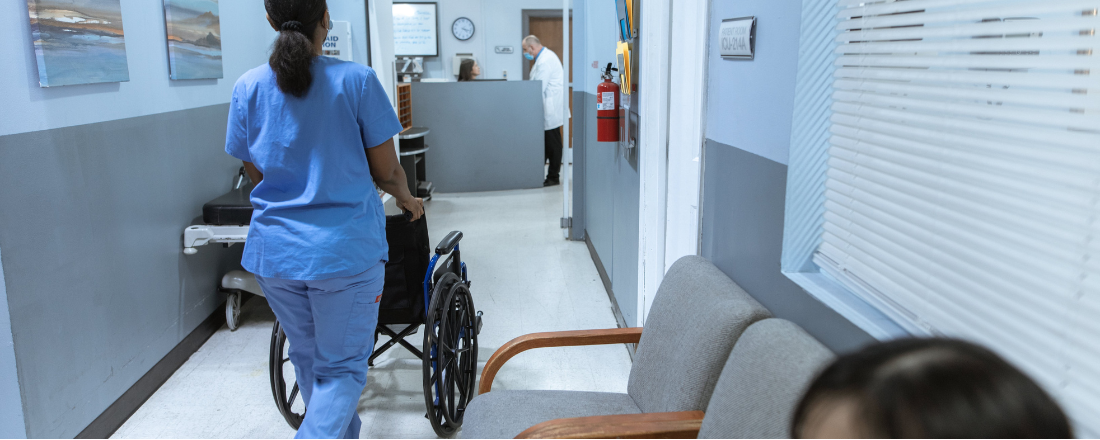
In the News
Patients Fear Barriers to Care with Medicaid Cuts
- Minnesota Reformer
-
Issues
Technology & Telehealth -
Programs
Center for Connected Health Policy -
Strategic Initiatives
COVID-19

“Courtney Blake and her 10-year-old daughter live on their own in Ypsilanti, Michigan. Both of them struggle with chronic mental health issues and have been using Medicaid to help pay for their behavioral health care needs. But like millions of people across the country, Blake is worried that at the end of this health emergency she might not be able to access the services she desperately needs to take care of herself and her daughter.
“As a single mother who is raising her child I’ve had no help financially for a really long time now,” Blake said. “I had some help from our family a few years ago, but we’re estranged now. So it’s just me and her.”
Usually, in order to receive Medicaid benefits, beneficiaries must recertify every year that they actually qualify, by meeting income criteria, for example. But during the first years of the pandemic, the federal government said states could get increased federal matching funds in exchange for allowing “ continuous enrollment ” and agreeing not to eject anyone from the program for any reason . Disenrollments were paused in early 2020 for states that opted in, including Michigan .
That’s scheduled to end on March 31 nationwide. And the public health emergency status is expected to expire shortly after that, in mid-May .
New estimates from the Kaiser Family Foundation show that since states stopped cutting people off from their health benefits as the pandemic began, 23.3 million more people enrolled in Medicaid and the Children’s Health Insurance Program (CHIP). A total 95 million people in the U.S. will be using those programs by the end of this month, when disenrollments resume.
But now around 7 million people are likely at risk of losing their Medicaid, according to early estimates from federal officials . In fact, Idaho already dropped thousands of people . The result is that people may not realize they no longer have insurance until they actually need care.
The situation is causing distress to many who are certainly at risk of being disenrolled, but there are other people like Blake who may fall just over the income threshold to qualify for full access to Medicaid services.
Falling into the gap
Blake is considered “medically needy,” and one of the ways she’s qualified for Medicaid in Michigan is by deducting her medical expenses from her income in order to meet the income threshold — what’s known as a “spend down,” which is like a deductible. After paying this amount, she can get her Medicaid benefits.
But during the public health emergency, she didn’t have to pay those higher co-pays for her medical bills, because the continuous enrollment provision got rid of that requirement. Now, people like her would have to pay those fees again, according to a spokesperson from the Centers for Medicare & Medicaid Services.
A greater toll
The COVID-19 pandemic exacerbated existing mental health issues, particularly for people with low incomes and those who’ve been marginalized. Studies have shown that the pandemic increased anxiety, depression, and stress among families with lower incomes. But accessing services has long been challenging for this population.
The American Psychological Association’s 2015 workforce survey found that almost two-thirds of responding psychologists rarely serve those with lower incomes. But even those providers who are serving patients with greater need, often find it difficult to accept Medicaid, due to low reimbursement rates.
Policy options can help close the gap
Courtney Blake is hoping that she can work through her spend-down at a community mental health center, which may be able to cover those co-pays for her. Similarly, Williams is hoping that the state Medicaid agency would make an exception for her son through the state’s “ Children’s Waiver Program ,” or “ Children with Serious Emotional Disturbance ” waiver program that would allow him to get Medicaid for his special mental health needs.
Some federal options already in the works
The Biden Administration announced a national mental health crisis strategy in March last year and unveiled the HHS Roadmap for Behavioral Health Integration in September. Some of the actions include:
- Federal funding for Certified Community Behavioral Health Clinics , which can offer mental health services at a lower cost especially for people on Medicaid, with lower income backgrounds, and those in rural areas. Last year, the administration awarded hundreds of millions of dollars to CCBHCs, and additionally awarded planning grants to 10 states, including Michigan , to expand the presence and services of CCBHCs.
- The establishment of a nationwide directory of opportunities for people to become crisis counselors for the “988” phone-line initiative that connects patients in crisis to information and resources on mental health care.
- Mental health training programs for peer support specialists to provide alternatives for people who cannot afford to see a psychologist or a licensed mental health professional. For example, the administration says the Department of Housing and Urban Development will launch a national effort to train housing counselors, among others, to recognize signs of emotional distress in residents and help connect them to mental health resources.
Another new flexibility that is likely here to stay is public health spending on telehealth services.

There are some states that tied their telehealth Medicaid waivers to the federal public health emergency, so once that’s declared over there’s obviously an expiration on those waivers. But many states have already settled on their telehealth policies permanently.Mei Kwong, JD
Executive Director, Center for Connected Health Policy, Public Health Institute
Kwong said although the policies are “all over the place,” there is one silver lining, which is that all states currently are reimbursing for telehealth services through Medicaid in some way.”
To read the full article, click on the link below.
Originally published by Minnesota Reformer
More Updates
Work With Us
You change the world. We do the rest. Explore fiscal sponsorship at PHI.
Support Us
Together, we can accelerate our response to public health’s most critical issues.
Find Employment
Begin your career at the Public Health Institute.



